HGST Deskstar NAS 6 TB Review
by Ganesh T S on December 23, 2014 11:00 AM ESTRAID-5 Benchmarking - Miscellaneous Aspects
Consumers are rightly worried about RAID rebuilds and the scope for drive failures during that process. As one of our evaluation aspects, we randomly yanked out a disk during operation and cleaned it up for rebuild. We recorded the resync duration (time taken to rebuild a 3-disk RAID-5 volume when one of the disks needs to be replaced) as well as the average power consumption during that process. The two aspects, considered together, give an idea of the efficiency of the hard drive. The graph below presents the total energy consumption (Resync Power Consumption (W) X Resync Duration (s)) for the resync.
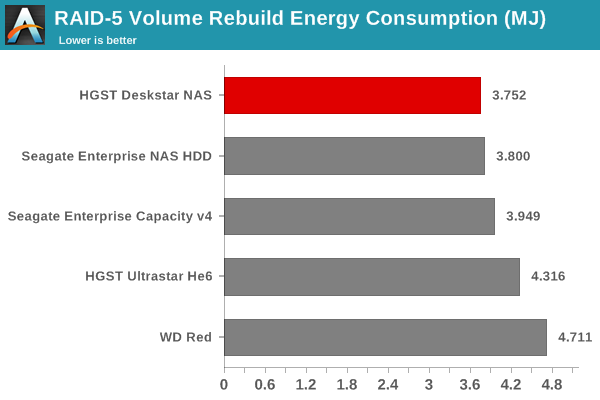
While the energy consumption aspect provides a consolidated view of the various factors, it is still worthwhile to look at the power consumption and resync duration numbers separately. The table below provides the raw information behind the above graph. We had a brief inkling when the temperature of the Deskstar NAS remained around 40 C only, despite more than 240 GB of continous data traffic, but the above energy consumption numbers confirm the fact that the Deskstar NAS is indeed quite efficient. That said, the raw power numbers do not look good for the Deskstar NAS in the table below. However, by getting done with the workloads earlier, the drive can go to the idle state quickly and keep system energy consumption resonable in the long run.
| RAID-5 Resync Power Consumption & Duration | ||
| Drive | Power (W) | Duration (s) |
| HGST Deskstar NAS | 101.46 | 36981 |
| WD Red | 90.48 | 52072 |
| Seagate Enterprise NAS HDD | 101.91 | 37284 |
| HGST Ultrastar He6 | 95.36 | 45260 |
| Seagate Enterprise Capacity v4 | 105.42 | 37462 |
We also measured power consumption during the last stage of our multi-client test. With 25 different clients simultaneously stressing the NAS with different types of workloads, we recorded the power consumption at the wall for the NAS as a whole. The various numbers are presented in the graphs below.
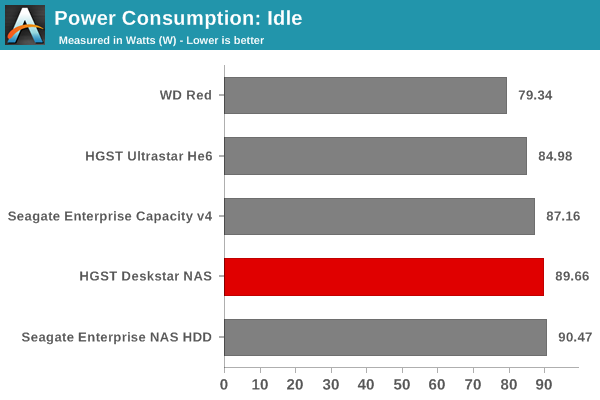
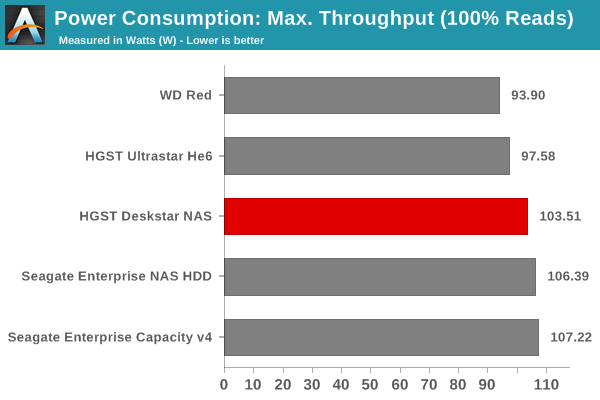
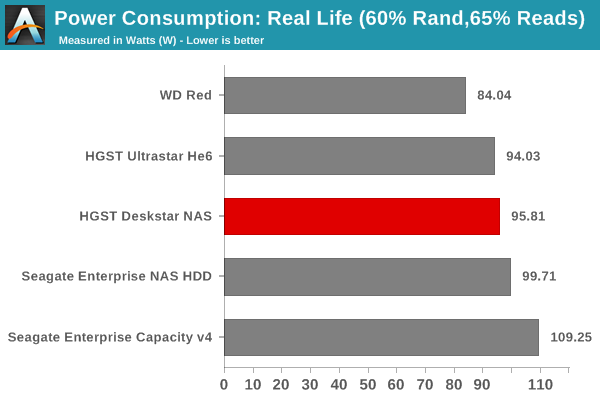
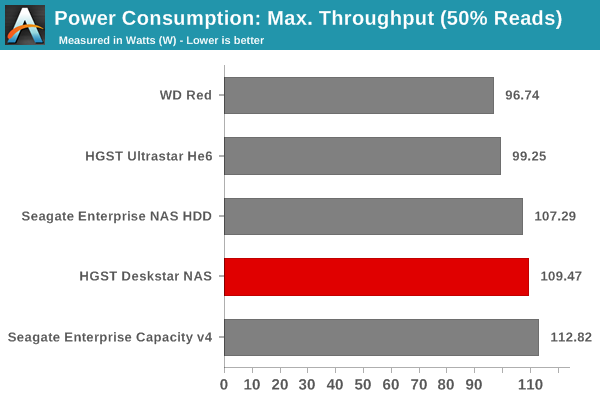
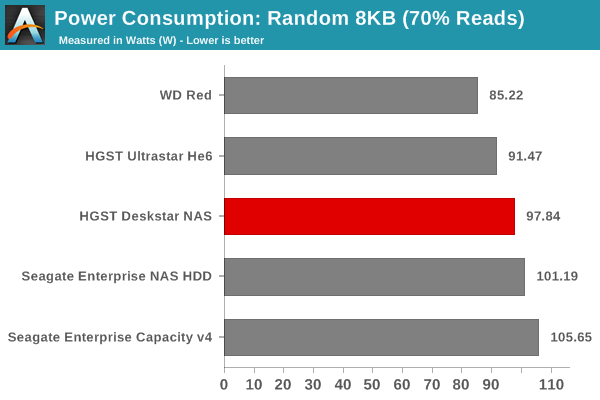
As expected, the units providing better performance have higher power consumption numbers. Amongst the 7200 RPM drives, the Ultrastar He6 is the most power-efficient. This is due to the HelioSeal technology (disks spinning in a sealed chamber filled with helium). Amongst the conventional drives, the Deskstar NAS manages to be the most power efficient for a few of the access patterns.










36 Comments
View All Comments
ganeshts - Tuesday, December 23, 2014 - link
There is no 6 TB WD Red Pro. In addition, this is meant for tower form-factor NAS units (that is why the name 'Deskstar'). The warranty and MTBF / URE ratings are closer to the WD Red than the WD Red Pro. For the rackmount units (which the WD Red Pro targets), HGST suggests the Ultrastar lineup.Samus - Tuesday, December 23, 2014 - link
initial large capacity drives are generally slow, especially in the case of a next-gen platter density increase, because the technology is not refined enough for higher spindle speeds. the sole exception are HGST's 8TB Helium drives, which are theoretically capable of 12TB capacities, but since its new technology, they want to play it conservatively and see how the 8TB reliability pans out.hlmcompany - Wednesday, December 24, 2014 - link
The WD Red Pro and the HGST Deskstar NAS have the same RPM, at 4TB the same cache size, also the same MTBF and the same Load/Unload cycles. Their data sheets describe similar operations: HGST - 1-5 bays, WD - 1-16 bays. The real difference is the warranty and URE. Yes, WD markets the Red Pro for rackmount use, but you'll see that WD doesn't use this drive in their own rackmount system or in their Arkeia rackmount systems - they use RE and SE drives for that purpose. Based on this spec data, I view it important to include the WD Red Pro in this comparison.http://www.wdc.com/wdproducts/library/SpecSheet/EN...
http://www.hgst.com/tech/techlib.nsf/techdocs/0BF8...$file/DS_NAS_spec.pdf
hlmcompany - Wednesday, December 24, 2014 - link
Also, if the HGST Deskstar NAS is not designed for a rackmount system, why would you test it one? Simply put, because there is no difference.ganeshts - Wednesday, December 24, 2014 - link
'rackmount' target vs 'tower form factor' : This has got more to do with the firmware aspects related to vibration tolerance. Rackmount system drives are engineered for more tolerance during extended use. It is more a reliability aspect.We chose a rackmount to keep things consistent across multiple drives. Our 'extended' tests only consists of running 24x7 for about a week (and only with three drives in the rack unit) - vibration tolerance doesn't affect our testbed setup much.
We are reviewing the 6 TB version here. If WD were to put out a 6 TB WD Red Pro, we would use that as a comparison point. As it stands, comparing a 4 TB drive and a 6 TB drive is like comparing apples and oranges.
Wwhat - Tuesday, December 23, 2014 - link
So HGST is what was hitachi and is now owned by western digital, so it's a WD drive really. Got it.You might have introduced it like that, but let's purch that thought and continue.
ganeshts - Tuesday, December 23, 2014 - link
Despite WD's purchase of HGST, the manufacturing facilities and product lines are still separate because China is yet to sanction the purchase fully:http://www.theregister.co.uk/2014/12/10/wd_mofcom_...
This is the reason why they have different products targeting the same market segment.. one from WD and one from HGST (for example, WD Red and HGST Deskstar NAS). So, this is NOT REALLY A WD drive, as you claim.
We have been covering HGST for quite some time (the WD acquisition was made in early 2012) : http://anandtech.com/tag/hgst : The way the products have been introduced in each of the reviews has not changed since then, as you can see for yourself.
jardows2 - Tuesday, December 23, 2014 - link
You, sir, are a troll. If you are so cynical about Purch acquiring AnandTech, go somewhere else. Anyone who has been following hard drives for the last two years knows HGST is owned by WD, but that they are separate entities. There is no need for anyone to point out the obvious.chrnochime - Tuesday, December 23, 2014 - link
And we all know how brilliant TH is these days....Go read this and be enlightened by how great Purch is:
http://www.overclock.net/t/1530926/anandtech-anand...
start from post #34, and read down. See how they put OCN as "renowned brands" even when they don't own OCN.
Doh! - Wednesday, December 24, 2014 - link
How does "renowned brands" translate into "ownership"? They could be simply doing advertising work on OCN. When I checked out that Purch webpage you mentioned, all I saw was a network of websites for their advertising "partners" listed as renowned brands. Not a single indication of ownership is existent.